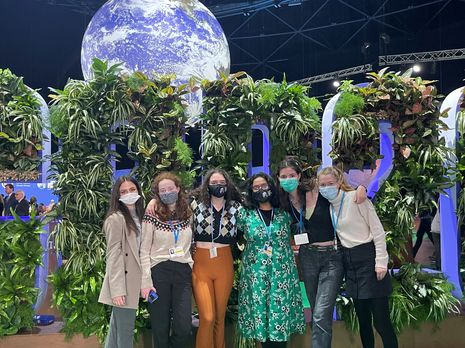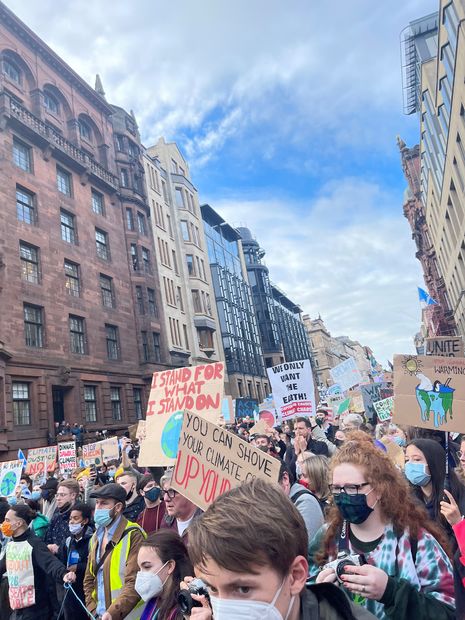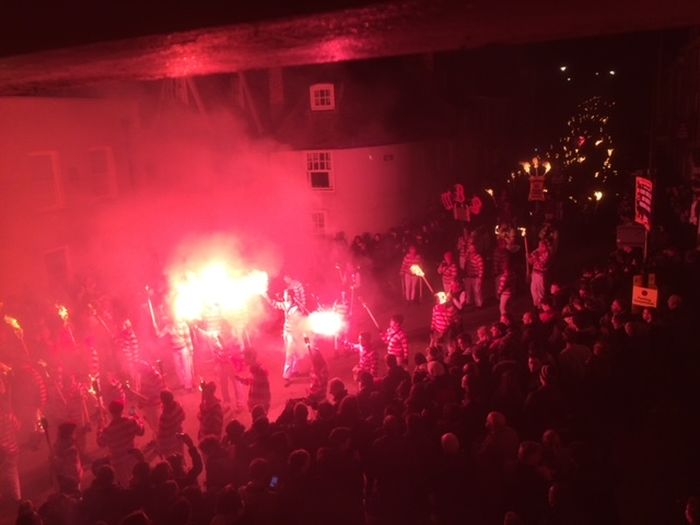Campaigning for change: looking at the hypocrisy of COP26
Beth Doherty reflects on her experiences after attending the 26th annual UN conference held to tackle the climate crisis

Frustrating, exciting, disheartening, empowering, enlightening. I want to be able to tell people that attending COP26, the 26th annual UN conference held to tackle the climate crisis, was incredible; that it was inspiring and made me hopeful for change. At times, it did. But it also showed me everything that is wrong with how we currently work.
COP26 is much bigger than what goes on inside the Blue (UN Designated) Zone – often progress comes from the outside, rather than from within. I spent my first three days outside COP26 attending protests and events and meeting other activists. The first protest was on Friday 5th November, and I arrived in time to join as a steward. Thousands of young people from all over the world united to demand change, highlighting what had gone wrong in the first week of the conference — the lack of transparency, equitable representation, and meaningful systemic action. The protest on Saturday continued with the same momentum. The march felt like a street festival, with chants coming from all directions, music, and an electric energy. This sense of collective power made it the day where I felt the most hopeful for the future.
“The interests of the industries at the heart of the crisis were far more represented than those fighting to end it”
Every year, events are run outside the conference by civil society groups. On Sunday, I attended the People’s Tribunal, a mock trial of the UN Framework Convention on Climate Change (UNFCCC). At the same time, my friends attended an action to Stop Cambo, a new oil field set to be approved by the UK government. Work has now been halted on the oil field – illustrating the power of collective action.
On entry to the conference, you’re greeted with many acronyms, but given no explanation of what they mean. In previous years, those with ‘observer’ badges like myself were able to observe the negotiations. This year, we weren’t even allowed in. Alongside this, the fossil fuel industry outnumbered us, with the biggest delegation. The interests of the industries at the heart of the crisis were far more represented than those fighting to end it.
The Blue Zone was split up into several different sections: the Action Hub (for activists, noticeably further from the rest of the conference than in previous years); pavilions where countries pay to show their ‘progress’ on climate action (lots of greenwashing here); negotiation spaces (which observers couldn’t observe, ironically); and offices for the participating countries.
“Those who are most responsible for the climate crisis are uplifted and glorified at the conference aimed at fixing it”
One thing not often talked about at COP26 is the sponsors. I remember running around trying to find a meeting room and passing the corporate sponsors of the conference. I felt pure rage at being reminded of the profit they make, while innocent people continue to die because of the crisis these sponsors are causing. Those who are most responsible for the climate crisis are uplifted and glorified at the conference aimed at fixing it.

A lot of our work inside the conference is focused on organising actions and creating pressure. Some of these actions included highlighting the $100 billion Obama promised for the Global South over 10 years ago during his address. On Gender Day, we stood in the conference with statistics about the need for gender justice within climate justice, including the fact that women have been excluded from the UK’s team for COP26. On the last day, hundreds of activists walked out to highlight the conference’s failures. In the evenings, we attended meetings to debrief and discuss collective steps for continuing activism within the conference.
These actions are crucial to ensuring transparency and accountability in the COP26 processes. Yet, throughout the week I was struck by how far away we were from the main spaces — and how that didn’t feel like an accident on the UK Presidency’s and UNFCCC’s behalf.
A common theme, among the people I spoke to, was a growing sense of disillusionment with UN processes; both how civil society was being locked out and the lack of concrete commitment or willingness for systemic change. This feeling was palpable across the conference. One activist I met, Yusuf Baluch, from Balochistan, expressed his frustration at how inaccessible and exclusionary COP26 was, telling me: “the climate crisis is caused by the exploitation and colonisation of indigenous lands, we must ensure that the rights of those most affected by the climate crisis are protected”.
I haven’t been able to include every experience from COP26, but I hope I’ve conveyed the chaotic sense of my experience: being constantly on my feet, working with others trying to create change, and yet being met with barriers on all sides. There was a marked difference between the days I spent inside and outside of COP – in energy, dynamics and hope. But we keep pushing because we need change. We need this to be heard, we need young people’s voices to be more than tokens to be played with.
Change will come, but not from COP26. If COP26 taught me anything, it’s that we need people power. We need everyone to come together, pushing for collective and systemic change. If you’re reading this and feeling frustrated, angry, sad, or anything in between – get involved. Begin demanding the change we need. We need the people to lead and together we can change this – even if our leaders aren’t prepared to do the same.
Links for getting involved:
Cambridge
UK
International
 News / Cambridge academics stand out in King’s 2026 Honours List2 January 2026
News / Cambridge academics stand out in King’s 2026 Honours List2 January 2026 Interviews / You don’t need to peak at Cambridge, says Robin Harding31 December 2025
Interviews / You don’t need to peak at Cambridge, says Robin Harding31 December 2025 Comment / What happened to men at Cambridge?31 December 2025
Comment / What happened to men at Cambridge?31 December 2025 Features / “It’s a momentary expression of rage”: reforming democracy from Cambridge4 January 2026
Features / “It’s a momentary expression of rage”: reforming democracy from Cambridge4 January 2026 News / Varsity’s biggest stories of 202531 December 2025
News / Varsity’s biggest stories of 202531 December 2025










